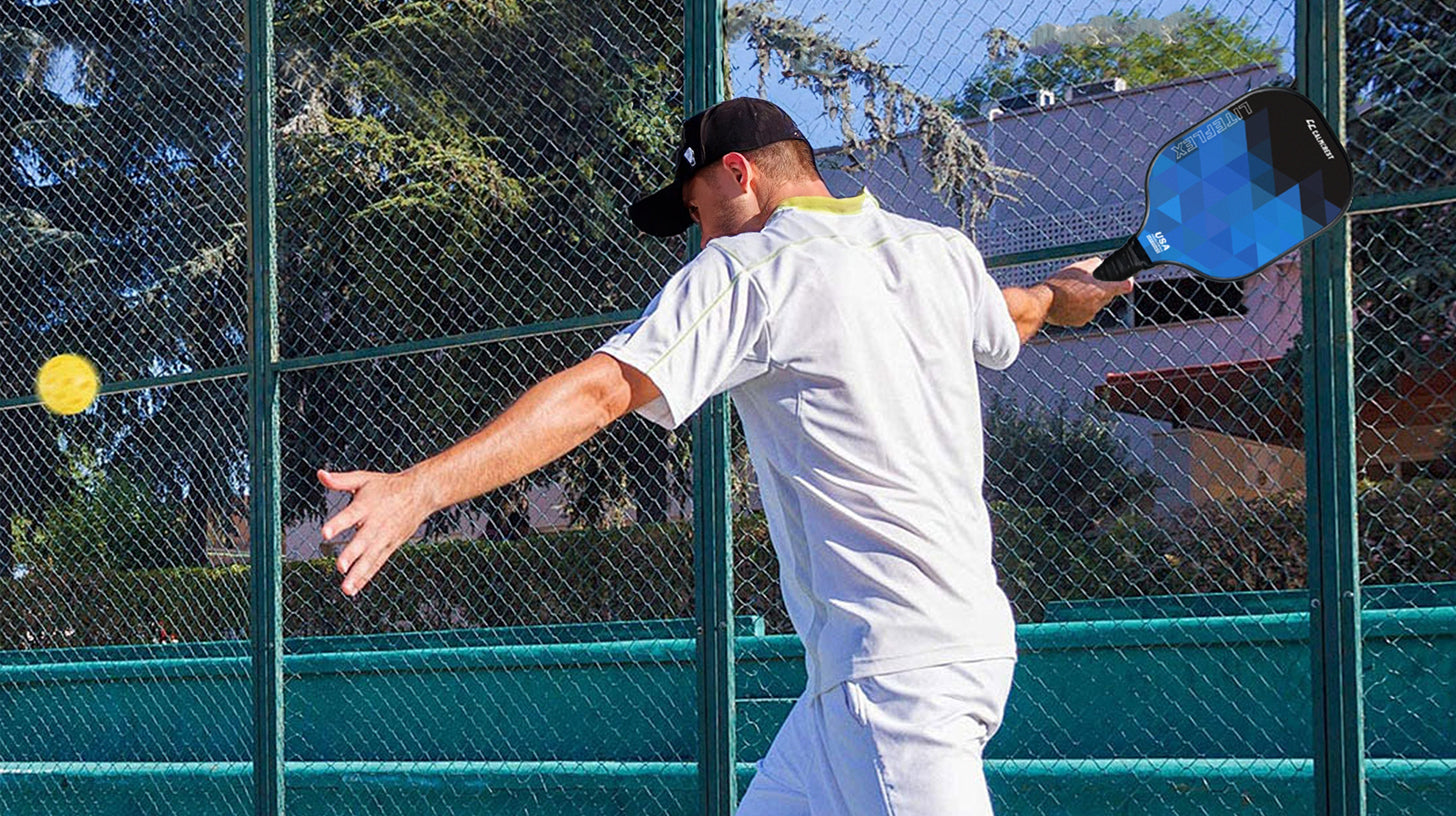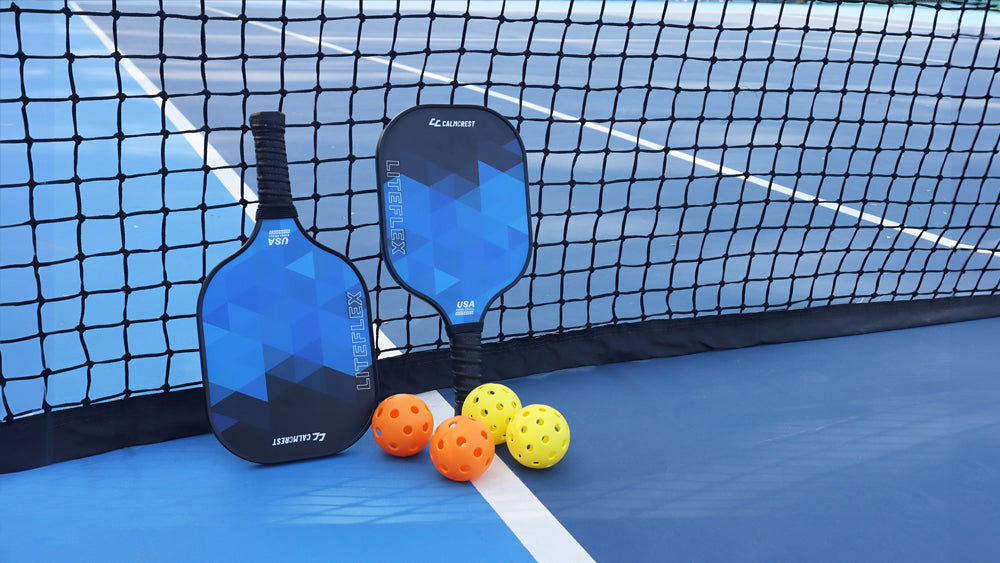The first pickleball paddles were crudely constructed out of wood in a workshop by one of the co-founders of the game. Since the 1960s, pickleball paddles have come so far, especially regarding innovations in materials. But which materials are available and how do you choose?
The most common pickleball paddle materials are graphite, carbon fiber, fiberglass, and wood. Hybrid options are also on the market. Depending on the type of material you select for your paddle, you can either generate more control or power when playing.
This introductory guide to pickleball paddle materials will go over all of your options. We’ll also talk about core materials, which are different from the surface or facing material you can actually see. By the time you’re done reading, you’ll know exactly which surface and core materials are best suited for your style of playing pickleball.
The Types of Pickleball Paddle Surface Materials
The following materials are commonly used for the surface or face material of a pickleball paddle. Remember, these are the exterior materials and not the cores.
Graphite Surface Paddles:
A graphite pickleball paddle is one of the lightest and thinnest surface materials you'll encounter. So thin in fact that the average thickness of one of these paddle faces can be mere millimeters. The lighter weight of graphite paddles might make you think they’re flimsy, but that couldn't be further from the truth; graphite is an incredibly rigid and stiff material.How Does a Graphite Paddle Play?
When playing, you'll feel a consistent strike and greater energy transfer between the ball and the paddle. The latter means your body will pick up some of the vibrations on each hit than other materials, although many factors contribute to this, such as core, construction, location of the ball, etc.
Graphite paddles are moderately powerful, meaning you can still hit hard shots, but you’ll have to rely on your technique more than just your paddle. In general, graphite is considered a material best suited for players that rely on touch over power.
Managing your energy is key so you don’t overswing and end up gassed in the middle of a game.
You'll find graphite paddle faces are used in casual, competitive, and tournament play, the choice is mostly made based on a player's style, leaning more towards finesse play.
Carbon Fiber Paddles:
Your next option for pickleball paddle face materials is carbon fiber. Like graphite, carbon fiber is quite stiff and light, but it's even more durable than graphite. Sounds similar to graphite, right? Well, that's because carbon fiber is technically a form of graphite.The easiest way to think of the two is based on how they are constructed. Graphite is more or less tightly packed layers of carbon, whereas carbon fiber is layered in ribbons and interlinked in a way that they form fibers, like weaving a piece of clothing. This is how it's able to create greater strength and rigidity while using less material to be lighter.
How Does a Carbon Fiber Paddle Play?
The feel of playing with a carbon fiber paddle has been described by players as refined.
The reason? The material is excellent at absorbing the impact energy of the ball as it strikes the paddle and then redistributes that energy - this is where the stiffness of the woven ribbons of carbon fiber shines. The even energy distribution keeps your shots consistent and precise. You’ll enjoy a greater degree of control and an increased ability to spin the ball.
The stiffness of carbon fiber, being comparable to graphite, means the paddle has about as much power too. That’s not to say a carbon fiber paddle lacks power, but again, you’ll have to be willing to put in more work for powerful shots. The durability of carbon fiber means it should have a longer playing life than a graphite surface.

Fiberglass Paddles:
Fiberglass is the most commonly found paddle surface material among rec players today. Fiberglass paddles are made when fibers are compressed under high degrees of heat and pressure. After that treatment, resin soaking produces a glass-like texture. If you’re looking for durability, it perhaps does not get any better than fiberglass. Increased durability doesn’t mean sacrificing weight, as fiberglass pickleball paddles weigh surprisingly little.
How Does a Fiberglass Paddle Play?
Where fiberglass diverges from graphite and carbon fiber is stiffness. Fiberglass isn’t as stiff, so this is the big reason fiberglass paddles are considered more of a power-driven paddle.
For beginners, the balance of fiberglass is very suitable as a first choice. After all, there is no need to buy carbon fiber materials several times the price when you try it. If you're new to pickleball, the pickleball sweet spot is an area on the paddle surface where it gets the highest-quality shot out of a hit - sometimes described as pop.
Fiberglass paddles may be a bit heavier than carbon fiber or graphite due to the extra power they provide, making them better at hitting hard shots.

Hybrid Paddles:
Some pickleball paddles aren’t made of one material at all, but rather, a combination of materials.
This mix of materials can be used to reinforce a paddle or give it more oomph when playing. Many combinations are available to bring out the best of both worlds in paddle materials.
You can use the three materials above to get a better understanding of how a paddle will behave. For instance, a paddle consisting of fiberglass and graphite could potentially offer you a larger sweet spot, with a greater balance between power and touch. A paddle with carbon-fiber and fiberglass may lean into a more refined feel with some extra power.
Like all things pickleball - everything is a balance, and most often it runs on a spectrum of control and power.
Wooden Paddles:
This is the original material, and perhaps more of a history lesson than something you should seek out to purchase if you're looking to play high-caliber pickleball, but it's important to know your roots, right?
Innovations in paddle technology mean that wood isn’t the popular material it once was, but it hasn’t been erased from pickleball paddles altogether. Many low-quality paddle starter sets are made from wood. So while we would never recommend a wooden paddle to any player, we think you should at least know how it plays.
How Does a Wooden Paddle Play?
There's nothing sophisticated about a wooden pickleball paddle - it's quite heavy for starters. This isn’t maybe something you’ll notice so much as you begin your pickleball games, but midway through or later, your wrist and arm may become sore.
You'll find that your accuracy is off because wooden paddles tend to hit very inconsistently. The wooden core is not as uniform as a honeycomb core and you will see it in your shots.
It is durable though, so long as you don't rough the edges with chips and scrapes. Because of the weight of wood, you can generate a great degree of power when playing with a wooden paddle, but they tend to have little surface grit so are hard to control. If you like to spin the ball, this isn't a great choice for you.
Is Graphite or Fiberglass Better for Pickleball?
Graphite and fiberglass are similar enough materials that you might feel stuck selecting between them. This is usually the biggest dilemma players face on their first paddle purchase - so which is better for your pickleball paddle?
Whether graphite or fiberglass is better depends on what you’re looking for in a pickleball paddle. If you want great handling and feel, then choose graphite. If you want more power, then a fiberglass paddle is the right choice for you.
Since fiberglass isn’t as stiff, it excels in the power department. Some players have complained that it doesn’t control as well though. Don’t necessarily let that deter you from selecting a fiberglass paddle. While each material is talked about as one or the other, it doesn't exclude the material from having attributes from both sides - in other words, a graphite paddle certainly has touch and control properties, but it doesn't mean there is zero power to the surface. It's just less pronounced than a fiberglass face.
Pickleball Paddle Core Materials and Why They’re Important
A pickleball paddle’s core will be made of a different material than the face. You don’t see the core, but it’s hugely important - and while this section will just focus on core materials, the thickness of the core is just as important to your playing experience as anything else.
Pickleball cores are designed with a structure like honeycombs. The empty cells are intended to create more strength in the paddle without driving up the weight. You can construct a core out of many materials, but some of the most common include polymer, aluminum, and Nomex.
Polymer Cores
The first material for a paddle core is a polymer. By far the most common core material in paddles, polymer core is also referred to as polypropylene, poly core, and sometimes just as poly.
The reason that polymer has become such a common material choice for a paddle core is because of how many great traits it has:
-
Touch & Power: You get some touch receptivity as well as some power but not too much of either.
-
Noise: A polymer core may also deliver a quieter playing experience, but a lot of that depends on how hard you’re hitting the ball.
-
Durability: The durability of polymer is another winning trait and some polymer cores are even recyclable. The strength and flexibility are also great features.
Polymer cores are not identical from one manufacturer to another. Some cores have smaller cells and others have larger cells. The number and size of cells contribute to core density. There are advantages to various core densities. For example, the smaller the honeycomb-like cells, the firmer, harder, and more powerful the paddle. This higher-density core is also more durable. Larger cells will deliver less power but more control. However, the larger cells are less durable and can develop dead spots sooner because they use less material.

Nomex Cores
Another pickleball paddle core material you can choose is Nomex, and this one has been around for a long time now. A DuPont product, Nomex is flame-resistant, heat-resistant, and polymer-based. Its honeycomb structure features many small cells.
Early pickleball paddles used Nomex cores because that was primarily what was available, but also because the inventor of this paddle was a Boeing engineer, and Nomex was widely used in aircraft construction. This core material has endured to this day, so it does have some redeeming qualities.
The biggest of those qualities is power. You get so much strength when playing with a Nomex paddle that it’s unbelievable. This can be a double-edged sword if you’re not careful. Combining too much of your power with a Nomex core paddle can easily cause you to whack the pickleball out of bounds and fault.
You need control and precision to play with one of these paddles. This is also something you can subdue with other areas of a paddle, like its weight, or using a graphite surface.
Nomex is both hard and dense. This means volleying the ball back and forth quickly can cause you to lose control, even if you’re more experienced. Despite their high degree of power, Nomex paddles are quite lightweight. You’ll find swinging easy too, even as a beginner.
Be ready to hear every shot if you’re playing with a Nomex paddle. Considering how easy it is to give a pickleball a hard whack with a Nomex paddle, everyone around you will know when you’re hitting.
Aluminum Cores
The next paddle core material is aluminum. It's far less common than polycore and even Nomex, but in the same way, you should be aware of wooden paddles, aluminum is worth noting. As you'd expect from aluminum anything, it's lightweight but lacks power.
As a beginner, you may not know what you're missing out on should you go with an aluminum core, but more experienced players will easily feel how an aluminum core is lacking.
Although you won’t hit the ball with much strength when playing with an aluminum paddle, you do get more control. For players who hit the ball out of bounds especially, an aluminum core might reduce those instances, but it would still not be the first choice in getting you more control on your shots.
How to Choose the Right Material for Your Pickleball PaddleLet's do a creative activity together; imagine you could only pick a paddle based on the core material and surface material. And to make that decision appropriate, they would have to be best suited for the type of game you want to play.
- Now, this is certainly not advised for how you ultimately pick a paddle for a couple of reasons. First, there is way more that goes into a paddle than just these two components - at a minimum, you would want to consider 5 factors before buying a pickleball paddle.
- Secondly, we've covered materials above that we would never recommend someone purchase.
But, this was all done in the spirit of educating you on what you may or may not see when trying to find a paddle. If we're on the same page there, then let's test your knowledge using only the surface and materials discussed in this article, let's answer each situation below:
If You Want Power:
Beginning with the core, a Nomex core is going to be one of the most powerful you can choose from. Don’t forget that in the case of Nomex, there is such a thing as too much power. If you feel overwhelmed by how your Nomex paddle performs to the point where you feel like you lack control when playing, then try a different paddle core instead.
If You Want Control:
You like your paddle to play with you, not against you. A more control-driven core material will certainly come from a polymer. You do get some degree of power with a polymer core, but it’s the least of the three -which means more control. Carbon fiber and graphite paddle faces are both lightweight and stiff enough that the control is in your hands the entire time you’re playing.
If You Want Lightweight Quality:
Do you want to keep it light while playing pickleball? An aluminum core might be the most lightweight material of the three. All pickleball face materials are moderately lightweight outside of wood. Carbon fiber and graphite would be among the lightest, but fiberglass is light as well.
Do keep in mind that depending on which hybrid materials you choose for your paddle, it could be somewhat heavier than what you’re used to.
If You Don’t Mind a Heavier Paddle:
What if you’re a more experienced pickleball player who doesn’t shy away from heavier paddles?
A polymer core is likely best for your paddle.
Calmcrest Has the Paddle You Need
We realize how overwhelming finding the perfect paddle can be, especially for someone just getting into pickleball. That's why we've compiled some of the best resources to help new and experienced players. While we've covered core and surface materials at length in this article, there's far more to picking a paddle than those two elements. If you're in the market for a new paddle, have a look at the following resources - they'll make sure you end up with the best paddle for you:



